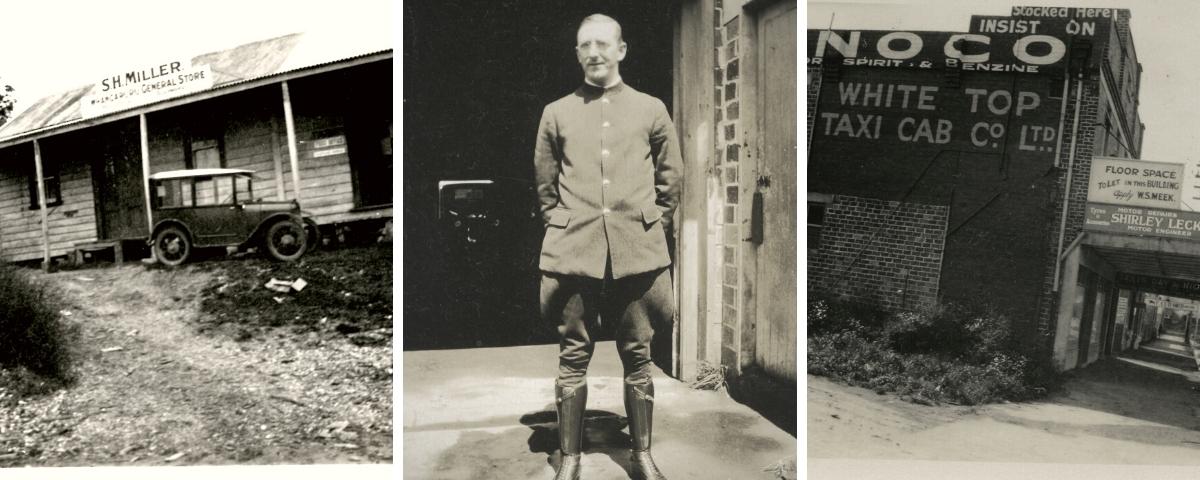Georgia Kerby, Exhibition Curator
Country roads around Whangārei were laid out in the 1860s and 70s, mainly to service local industries of gum and dairy. However, these remained a challenge to horse drawn vehicles and travelling plans were rendered unreliable by weather.
One of the first petrol powered public transport services was Hardie Brother’s truck run between Kamo and Whangārei. Over the following twenty years, several small and amalgamated bus services connected Whangārei to the region. These include those run by M. Mason and H. Wilkinson who became the Northern Motor Bus Company, Smith and Woodman, B. Moffatt, Dalbeth Motors, Erceg Motors, Webb Motors, and E. Ralls.
By the 1920s and 30s the roads were more reliable and opened options for ever-improving motor vehicles. Enter White Top Taxi Cab Company, providing both motorised transport around town as well as longer tourist drives around Northland.
Whangarei Museum is fortunate to have a collection of photographs donated by M. Terryy of the Waipu Informal Genealogy Group. The photographs record several of White Top’s vehicles and staff and were taken by employee Archie Cope. White Top Taxis were formally registered as a company in Auckland in 1927, by partners J. Ashton, A. Cope, J. Fuge, J. Covavich and L. Egginton. At the time, their only competition in town were Kia Ora Motors of James Street.
White Top Taxis had two premises during the time they were operating. The first was a garage below Gardner’s Hall in a double storey brick building on Rathbone Street, sensibly shared with Shirley Lecky motor engineer. They then opened a new establishment in 1931 in the old Britannia Theatre building (prev. Theatre Royal) on lower Bank Street, next to the Commercial Hotel (now the Grand). Making White Top’s taxis stand out was, of course, their dark bodies and white tops. The taxis themselves were Austins, imported from America.
Repairs and car maintenance were carried out in the Bank Street workshop, accessed by a driveway positioned through the archway of the original theatre entrance. What a squeeze! Although it appears very dark in the photos, an outdoor area was available behind the building and the original theatre floor had been ripped up and replaced with a metalled floor. Drivers may have been able to fill up their cabs out the back as the company applied for permit to install a petrol pump and a pipe from Vine Street. It is unknown whether this feature was approved.
Some of the staff pictured in this photograph collection are the Ivan Cocovich, Joe Fuge and son Neil, Archie Cope, Gordon Eyles, and Esme Alderson, who worked in the office and married Ivan Cocovich. Another service provided was the hire of a Rolls Royce for weddings, so I expect at least on was present at the Cocovich’s.
The same year, White Top Taxis became the local representatives of tourist service White Star. Cars left from White Top’s office to locations all over Northland and regularly connected with vehicles from Auckland and Hamilton. One such tour travelled from Whangārei to Mangakahia, Kaikohe, Rawene, Opononi, Kaihu, Dargaville and back to Whangārei.
Much like today, there were only a couple of taxi companies sharing Whangārei territory in the Thirties. Checker Cabs were White Taxis’ rivals and were based directly across the road. Competition clearly heated up following the move to Bank Street as there are several articles published in the Northern Advocate detailing a “taxi war”. Firstly, the council had to apologise for false statements and acknowledge that limits could not be put on which taxi companies waited at certain taxi stands in town. In 1934, White Tops introduced a “Tiny White Tops’ trade using smaller cars which carried only three people. Just before this, Checkers Cabs discounted their fares, so it appears that both companies were being creative with marketing strategies. A standard minimum taxi fare was released soon after to counter a wave of chaotic price undercuts.
By 1936, the struggle of competition was solved by the joining of the two rival taxi companies to become All Black Cabs, who operated out of the same Bank Street office. While the cars themselves have changed, Whangarei’s taxi services have not changed much in the last century owing to the increase in privately owned cars. It will be interesting to see what else changes for public transport in the future, with changes for electric cars, tour buses and council run networks.
